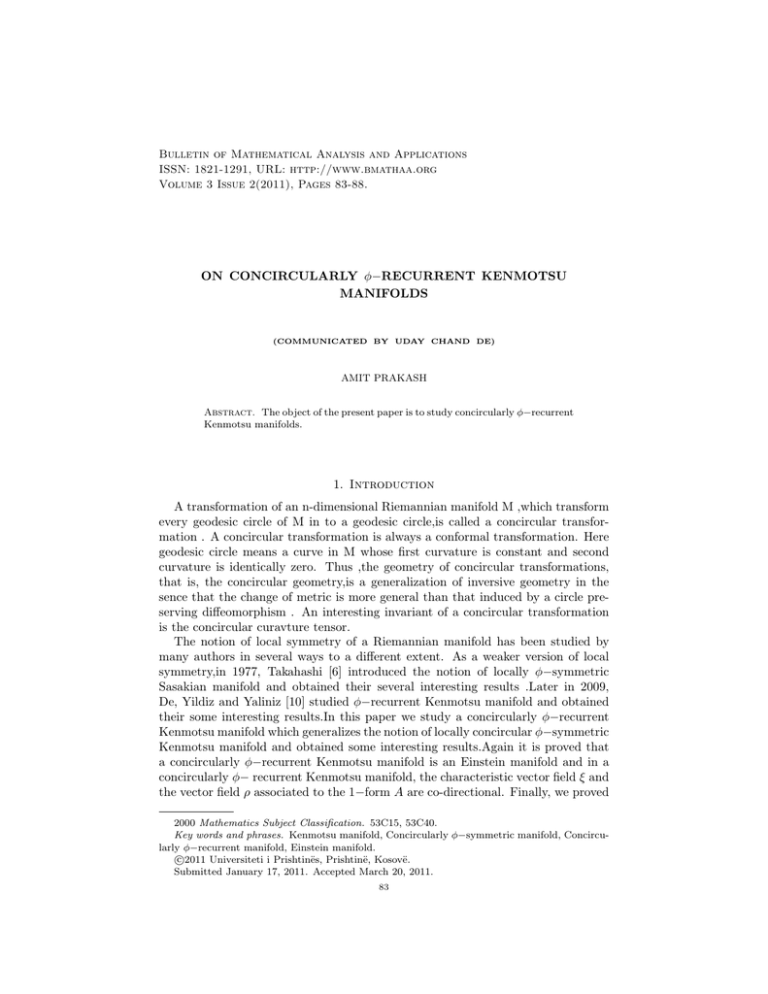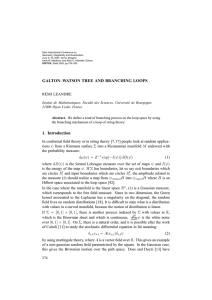Bulletin of Mathematical Analysis and Applications ISSN: 1821-1291, URL:
advertisement

Bulletin of Mathematical Analysis and Applications
ISSN: 1821-1291, URL: http://www.bmathaa.org
Volume 3 Issue 2(2011), Pages 83-88.
ON CONCIRCULARLY ϕ−RECURRENT KENMOTSU
MANIFOLDS
(COMMUNICATED BY UDAY CHAND DE)
AMIT PRAKASH
Abstract. The object of the present paper is to study concircularly ϕ−recurrent
Kenmotsu manifolds.
1. Introduction
A transformation of an n-dimensional Riemannian manifold M ,which transform
every geodesic circle of M in to a geodesic circle,is called a concircular transformation . A concircular transformation is always a conformal transformation. Here
geodesic circle means a curve in M whose first curvature is constant and second
curvature is identically zero. Thus ,the geometry of concircular transformations,
that is, the concircular geometry,is a generalization of inversive geometry in the
sence that the change of metric is more general than that induced by a circle preserving diffeomorphism . An interesting invariant of a concircular transformation
is the concircular curavture tensor.
The notion of local symmetry of a Riemannian manifold has been studied by
many authors in several ways to a different extent. As a weaker version of local
symmetry,in 1977, Takahashi [6] introduced the notion of locally ϕ−symmetric
Sasakian manifold and obtained their several interesting results .Later in 2009,
De, Yildiz and Yaliniz [10] studied ϕ−recurrent Kenmotsu manifold and obtained
their some interesting results.In this paper we study a concircularly ϕ−recurrent
Kenmotsu manifold which generalizes the notion of locally concircular ϕ−symmetric
Kenmotsu manifold and obtained some interesting results.Again it is proved that
a concircularly ϕ−recurrent Kenmotsu manifold is an Einstein manifold and in a
concircularly ϕ− recurrent Kenmotsu manifold, the characteristic vector field ξ and
the vector field ρ associated to the 1−form A are co-directional. Finally, we proved
2000 Mathematics Subject Classification. 53C15, 53C40.
Key words and phrases. Kenmotsu manifold, Concircularly ϕ−symmetric manifold, Concircularly ϕ−recurrent manifold, Einstein manifold.
c
⃝2011
Universiteti i Prishtinës, Prishtinë, Kosovë.
Submitted January 17, 2011. Accepted March 20, 2011.
83
84
AMIT PRAKASH
that a three dimensional locally concircularly ϕ−recurrent Kenmotsu manifold is
of constant curvature.
2. Preliminaries
Let M 2n+1 (ϕ, ξ, η, g) be an almost contact Riemannian manifold, where ϕ is
a (1, 1) tensor field, ξ is the structure vector field, η is a 1−form and g is the
Riemannian metric.It is well known that the structure (ϕ, ξ, η, g) satisfy
ϕ2 X = −X + η(X)ξ,
(2.1)
(a) η(ξ) = 1, (b) g(X, ξ) = η(X), (c) η(ϕX) = 0, (d) ϕξ = 0,
g(ϕX, ϕY ) = g(X, Y ) − η(X)η(Y ),
(DX ϕ)(Y ) = −g(X, ϕY )ξ − η(Y )ϕX,
DX ξ = X − η(X)ξ,
(2.2)
(2.3)
(2.4)
(2.5)
(DX η)(Y ) = g(X, Y ) − η(X)η(Y ),
(2.6)
for all vector fields X, Y, Z, where D denotes the operator of covariant differentiation
with respect to g ,then M 2n+1 (ϕ, ξ, η, g) is called an almost Kenmotsu manifold [4].
Kenmotsu manifolds have been studied by many authors such as Binh, Tamassy,
De and Tarafdar [7],De and Pathak [9],Jun, De and Pathak [3], Ozgur and De [1]
and many others.
In a Kenmotsu manifold the following relations hold: [4]
η(R(X, Y )Z) = g(X, Z)η(Y ) − g(Y, Z)η(X)
(2.7)
R(X, Y )ξ = η(X)Y − η(Y )X,
(2.8)
S(ϕX, ϕY ) = S(X, Y ) + 2nη(X)η(Y ),
(2.9)
S(X, ξ) = −2nη(X),
(2.10)
for all vector fields X, Y, Z, where S is the Ricci tensor of type (0, 2) and R is the
Riemannian curvature tensor of the manifold.
Definition 2.1. A Kenmotsu manifold is said to be a locally ϕ-symmetric manifold
if [6]
ϕ2 ((DW R)(X, Y )Z) = 0,
(2.11)
for all vector fields X, Y, Z, W orthogonal to ξ.
Definition 2.2. A Kenmotsu manifold is said to be a locally concircularly ϕ−symmetric
manifold if
ϕ2 ((DW C)(X, Y )Z) = 0,
(2.12)
for all vector fields X,Y,Z,W orthogonal to ξ.
Definition 2.3. A Kenmotsu manifold is said to be concircularly ϕ−recurrent
Kenmotsu manifold if there exists a non-zero 1-form A such that
ϕ2 ((DW C)(X, Y )Z) = A(W )C(X, Y )Z,
(2.13)
for arbitrary vector fields X, Y, Z, W , where C is a concircular curvature tensor
given by [5]
r
[g(Y, Z)X − g(X, Z)Y ],
(2.14)
C(X, Y )Z = R(X, Y )Z −
2n(2n + 1)
where R is the Riemann curvature tensor and r is the scalar curvature.
If the 1-form A vanishes, then the manifold reduces to a locally concircularly
ϕ−symmetric manifold.
ON CONCIRCULARLY ϕ−RECURRENT KENMOTSU MANIFOLDS
85
3. Concircularly ϕ−recurrent Kenmotsu manifold
Let us consider a concircularly ϕ−recurrent Kenmotsu manifold. Then by virtue
of (2.1) and (2.13), we get
− (DW C)(X, Y )Z + η((DW C)(X, Y )Z)ξ = A(W )C(X, Y )Z,
(3.1)
from which it follows that
− g((DW C)(X, Y )Z, U ) + η((DW C)(X, Y )Z)η(U ) = A(W )g(C(X, Y )Z, U ). (3.2)
Let {ei }, i = 1, 2, ........2n + 1 be an orthonormal basis of the tangent space at any
point of the manifold.Then putting X = U = ei in (3.2) and taking summation
over i , 1 ≤ i ≤ 2n + 1, we get
dr(W )
dr(W )
g(Y, Z) −
[g(Y, Z) − η(Y )η(Z)]
(2n + 1)
2n(2n + 1)
r
− A(W )[S(Y, Z) −
g(Y, Z)].
(3.3)
2n + 1
(DW S)(Y, Z) =
Replacing Z by ξ in (3.3) and using (2.5) and (2.10), we get
(DW S)(Y, ξ) =
dr(W )
r
η(Y ) − A(W )[2n −
]η(Y ).
(2n + 1)
2n + 1
(3.4)
Now we have
(DW S)(Y, ξ) = DW S(Y, ξ) − S(DW Y, ξ) − S(Y, DW ξ)
Using (2.5) ,(2.6) and (2.10) in the above relation,it follows that
(DW S)(Y, ξ) = −2ng(Y, W ) − S(Y, W ).
(3.5)
In view of (3.4) and (3.5),we get
S(Y, W ) = −2ng(Y, W ) −
dr(W )
r
η(Y ) + A(W )[2n −
]η(Y ).
2n + 1
2n + 1
(3.6)
. Replacing Y by ϕY in (3.6) ,we get
S(ϕY, W ) = −2ng(ϕY, W ).
(3.7)
Again replacing W by ϕW in (3.7) and using(2.3) and(2.9),we get
S(Y, W ) = −2ng(Y, W ),
for all Y, W .
Hence, we can state the following theorem:
Theorem 3.1. A Concircularly ϕ−recurrent Kenmotsu manifold (M 2n+1 , g) is an
Einstein manifold.
Now from (3.1) ,we have
(DW C)(X, Y )Z = η((DW C)(X, Y )Z)ξ − A(W )C(X, Y )Z.
(3.8)
86
AMIT PRAKASH
Using (2.14) in (3.8),we get
(DW R)(X, Y )Z
= η((DW R)(X, Y )Z)ξ − A(W )R(X, Y )Z
dr(W )
−
[g(Y, Z)η(X)ξ − g(X, Z)η(Y )ξ]
2n(2n + 1)
dr(W )
+
[g(Y, Z)X − g(X, Z)Y ]
2n(2n + 1)
r
+
A(W )[g(Y, Z)X − g(X, Z)Y ].
2n(2n + 1)
(3.9)
From (3.9) and the Bianchi identity,we get
A(W )η(R(X, Y )Z) + A(X)η(R(Y, W )Z) + A(Y )η(R(W, X)Z)
r
=
A(W )[g(Y, Z)η(X) − g(X, Z)η(Y )]
2n(2n + 1)
r
+
A(X)[g(Z, W )η(Y ) − g(Y, Z)η(W )]
2n(2n + 1)
r
+
A(Y )[g(X, Z)η(W ) − g(W, Z)η(X)].
(3.10)
2n(2n + 1)
Putting Y = Z = ei in (3.10) and taking summation over i, 1 ≤ i ≤ 2n + 1, we get
A(W )η(X) = A(X)η(W ),
(3.11)
for all vector fields X, W . Replacing X by ξ in (3.11) ,we get
A(W ) = η(W )η(ρ),
(3.12)
for any vector field W , where A(ξ) = g(ξ, ρ) = η(ρ), ρ being the vector field associated to the 1−form A i.e., A(X) = g(X, ρ). From (3.11) and (3.12) ,we can state
the following theorem:
Theorem 3.2. In a Concircularly ϕ- recurrent Kenmotsu manifold (M 2n+1 , g)
(n ≥ 1), the characteristic vector field ξ and the vector field ρ associated to the
1-form A are co-directional and the 1-form A is given by (3.12).
4. On 3-dimensional locally concircularly ϕ-recurrent Kenmotsu
manifolds
It is known that in a three dimensional Kenmotsu manifold the curvature tensor
has the following form [9]
R(X, Y )Z
=
r+4
)[g(Y, Z)X − g(X, Z)Y ]
2
(r + 6)
−
[g(Y, Z)η(X)ξ − g(X, Z)η(Y )ξ
2
+η(Y )η(Z)X − η(X)η(Z)Y ].
(
(4.1)
ON CONCIRCULARLY ϕ−RECURRENT KENMOTSU MANIFOLDS
87
Taking covariant differentiation of (4.1), we get
(DW R)(X, Y )Z
dr(W )
[g(Y, Z)X − g(X, Z)Y ]
2
dr(W )
−
[g(Y, Z)η(X)ξ − g(X, Z)η(Y )ξ
2
+η(Y )η(Z)X − η(X)η(Z)Y ]
r+6
−
[g(Y, Z)(DW η)(X)ξ + g(Y, Z)η(X)(DW ξ)
2
−g(X, Z)(DW η)(Y )ξ − g(X, Z)η(Y )(DW ξ)
=
+(DW η)(Y )η(Z)X + (DW η)(Z)η(Y )X
−(DW η)(X)η(Z)Y − (DW η)(Z)η(X)Y ].
(4.2)
Taking X,Y,Z,W orthogonal to ξ and using (2.5) and (2.6),we get
(DW R)(X, Y )Z
dr(W )
[g(Y, Z)X − g(X, Z)Y ]
2
r+6
−
[g(Y, Z)g(X, W ) − g(X, Z)g(Y, W )]ξ.
2
=
(4.3)
From (4.3)it follows that
ϕ2 (DW R)(X, Y )Z =
dr(W )
[g(Y, Z)ϕ2 X − g(X, Z)ϕ2 Y ].
2
(4.4)
Now taking X,Y,Z,W orthogonal to ξ and using (2.1) and (2.2) in(4.4),we get
ϕ2 (DW R)(X, Y )Z = −
dr(W )
[g(Y, Z)X − g(X, Z)Y ].
2
(4.5)
Differentiating covariantly (2.14) with respect to W (for n=1),we get
dr(W )
[g(Y, Z)X − g(X, Z)Y ].
6
Now applying ϕ2 to the both sides of (4.6), we get
(DW C)(X, Y )Z = (DW R)(X, Y )Z −
(4.6)
ϕ2 (DW C)(X, Y )Z = ϕ2 (DW R)(X, Y )Z −
dr(W )
[g(Y, Z)ϕ2 X − g(X, Z)ϕ2 Y ].
6
(4.7)
Now using (2.13), (4.5), (2.1) in (4.7),we obtain
A(W )C(X, Y )Z
dr(W )
[g(Y, Z)X − g(X, Z)Y ]
2
dr(W )
+
[g(Y, Z)X − g(X, Z)Y
6
+g(X, Z)η(Y )ξ − g(Y, Z)η(X)ξ].
= −
(4.8)
Taking X,Y,Z,W orthogonal to ξ, we get
C(X, Y )Z
=
−
dr(W )
[g(Y, Z)X − g(X, Z)Y ].
3A(W )
(4.9)
88
AMIT PRAKASH
Putting W={ei } in (4.9), where {ei }, i=1, 2, 3 is an orthonormal basis of the
tangent space at any point of the manifold and taking summation over i, 1 ≤ i ≤
3,we obtain
dr(ei )
C(X, Y )Z = −
[g(Y, Z)X − g(X, Z)Y ].
3A(ei )
(4.10)
Using (2.14) in (4.10), we get
R(X, Y )Z
= λ[g(Y, Z)X − g(X, Z)Y ],
(4.11)
dr(ei )
where λ = [ 6r − 3A(e
] is a scalar, Since A is a non-zero 1- form.Then by schur’s
i)
theorem λ will be a constant on the manifold.Therefore, M 3 is of constant curvatare
λ.Hence we can state the following theorem:
Theorem 4.1. A 3- dimensional locally concircularly ϕ-recurrent kenmotsu manifold is of constant curvature
Acknowledgments. The author would like to thank the anonymous referee for
his comments that helped us improve this article.
References
[1] C. Ozgur and U.C.De, On the quasi-conformal curvature tensor of a Kenmotsu manifold,
Mathematica Pannonica, 17(2)(2006), 221-228.
[2] D. E.Blair, Contact manifolds in Riemannian geometry,Lecture Notes in Math. 509
(1976),Berlin-Heidelberg-New York.
[3] J.B.Jun,U.C.De and G.Pathak, On Kenmotsu manifolds, J.Korean Math.Soc.,42(2005),435445.
[4] K.Kenmotsu, A class of almost contact Riemannian manifolds, Tohoku Math. J.,24(1972),
93-103.
[5] K.Yano , Concircular geometry, Proc. Imp. Acad., Tokyo, 16 (1940), 195-200.
[6] T.Takahashi , Sasakian ϕ− symmetric spaces, Tohoku Math. J ., 29 (1977), 91-113.
[7] T. Q.Binh, L.Tamassy,U.C.De and M.Tarafdar, Some remarks on almost Kenmotsu manifolds,Mathematica Pannonica,13 (2002), 31-39.
[8] U.C.De, A.A.Shaikh and S.Biswas , On ϕ− Recurrent Sasakian manifolds,Novi Sad J.
Math,33(2) (2003), 43-48.
[9] U.C.De and G.Pathak, On 3-Dimensional Kenmotsu Manifolds, Indian J.pure appl.
Math.,35(2) (2004),159-165.
[10] U.C.De, A.Yildiz and A.F.Yaliniz , On ϕ− Recurrent Kenmotsu manifolds,Turk J. Math.,33
(2009),17-25.
[11] U.C.De, On ϕ-symmetric Kenmotsu manifolds,Int.Electronic J. Geometry 1(1)(2008),33-38.
Department of Mathematics and Statistics
Faculty of Science, D.D.U.Gorakhpur University, Gorakhpur 273009, U.P. India .
E-mail address: apoct0185@rediffmail.com





